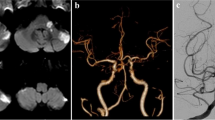Abstract
The advances in neuroimaging have improved clinicoanatomic correlations in patients with stroke. Junctional infarct is a distinct term, used to describe border zone infarcts of the posterior fossa. We presented computed tomography (CT) and magnetic resonance imaging (MRI) findings in a rare case of bilateral symmetrical junctional infarcts between the superior cerebellar artery (SCA) and posterior inferior cerebellar artery (PICA) territories. In addition to precise knowledge of arterial territories required to achieve accurate localization of ischemic lesions on CT and MRI, the radiologist must also be aware of radiologic features and geographic territories of cerebellar arteries and their junctional infarctions.

Similar content being viewed by others
References
Amarenco P (1991) The spectrum of cerebellar infarctions. Neurology 41:973–979
Amarenco P, Hauw JJ (1989) Anatomie des artères cérébelleuses. Rev Neurol 145:267–276
Amarenco P, Hauw JJ (1990) Cerebellar infarction in the territory of the superior cerebellar artery. A clinico-pathological study of 20 cases. Brain 113:139–155
Amarenco P, Hauw JJ (1990) Cerebellar infarction in the territory of the superior cerebellar artery. A clinicopathological study of 33 cases. Neurology 40:1383–1390
Amarenco P, Kase SC, Rosengart A, Pessin MS, Bousser MR, Caplan R (1993) Very small (border zone) cerebellar infarcts. Brain 116:161–186
Barth A, Bogousslavsky J, Regli F (1993) The clinical and topographic spectrum of cerebellar infarcts: a clinical magnetic resonance imaging correlation study. Ann Neurol 33:451–456
Baum PA, Barkovich AJ, Koch TK, Berg BO (1994) Deep gray matter involvement in children with acute disseminated encephalomyelitis. AJNR 15:1275–1283
Caldemeyer KS, Smith RR, Harris TM (1994) MRI in acute disseminated encephalomyelitis. Neuroradiology 36:216–220
Canaple S, Bogousslavsky J (1999) Multiple large and cerebellar infarctions. J Neurol Neurosurg Psychiatry 66:739–745
Chabas D, Strober J, Waubant E (2008) Pediatric multiple sclerosis. Curr Neurol Neurosci Rep 8:434–441
Cormier PJ, Long ER, Russell EJ (1992) MR imaging of posterior fossa infarctions: vascular territories and clinical correlates. Radiographics 12:1079–1092
Hayman LA, Evans RA, Hinck VC (1980) Delayed high-iodine dose contrast computed tomography: cranial neoplasms. Radiology 136:677–684
Katz D, Taubenberger JK, Canella B, McFarlin DE, Raine CS, McFarland HF (1993) Correlation between magnetic resonance imaging findings and lesion development in chronic, active multiple sclerosis. Ann Neurol 34:661–669
Marinkovic S, Kovacevic M, Gibo H, Milisavljevic M, Bumbasirevic L (1995) The anatomical basis for the cerebellar infarcts. Surg Neurol 44:450–461
Pullicino PM (1993) Diagrams of perforating artery territories in axial, coronal and sagittal planes. Adv Neurol 62:41–73
Savoiardo M, Bracchi M, Passerini A, Visciani A (1987) The vascular territories in the cerebellum and brainstem: CT and MR study. AJNR Am J Neuroradiol 8:199–209
Swiontoniowski M, Biller J, Azar-Kia B, Fine M (1985) Cerebellar infarction-clinical and cranial computerized tomography correlations. Eur Neurol 24:338–342
Tatu L, Moulin T, Bogousslavsky J, Duvernoy H (1996) Arterial territories of human brain: brainstem and cerebellum. Neurology 47:1125–1135
Tekinsoy B, Usal C, Erbayraktar S, Acar U (2001) Bilateral junctional infarction of the cerebellum. Turk J Intervent Radiol 7:337–339
Yurtsever I, Hakyemez B, Taskapilioglu O, Erdoğan C, Turan OF, Parlak M (2008) The contribution of diffusion-weighted MR imaging in multiple sclerosis during acute attack. Eur J Radiol 65:421–426
Zimmerman RA, Haselgrove JC, Wang Z, Hunter JV, Morris MC, Hoydu A, Bilaniuk LT (1998) Advances in pediatric neuroimaging. Brain Dev 20:275–289
Author information
Authors and Affiliations
Corresponding author
Rights and permissions
About this article
Cite this article
Kiroğlu, Y., Karabulut, N., Oncel, C. et al. Bilateral symmetric junctional infarctions of the cerebellum: a case report. Surg Radiol Anat 32, 509–512 (2010). https://doi.org/10.1007/s00276-009-0560-5
Received:
Accepted:
Published:
Issue Date:
DOI: https://doi.org/10.1007/s00276-009-0560-5




